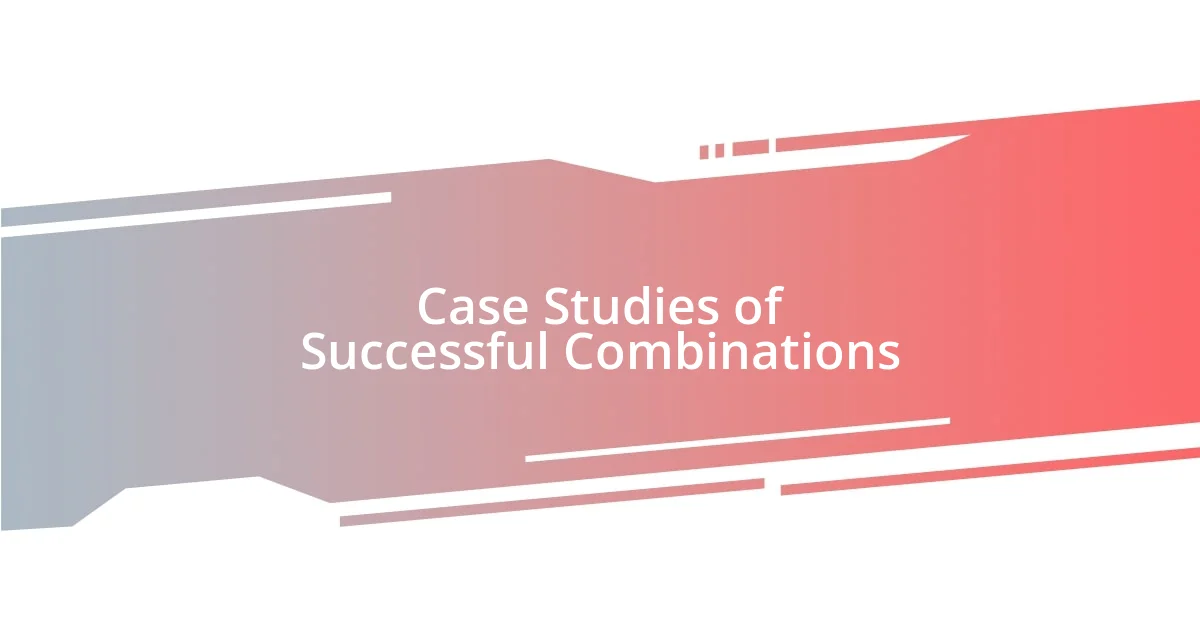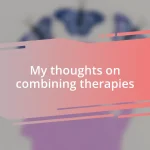Key takeaways:
- Combining different therapeutic approaches enhances healing by tailoring the experience to individual needs, as seen with successful integrations like CBT with mindfulness and art therapy with CBT.
- The therapeutic alliance and clear goal-setting between therapist and client are crucial for effective therapy outcomes, fostering a safe environment for vulnerability and growth.
- Flexible and gradual integration of therapies, along with open communication, can lead to transformative breakthroughs and deeper connections in the therapeutic process.

Introduction to Therapy Combination
Combining different therapeutic approaches is becoming increasingly popular among mental health professionals and patients alike. Personally, I’ve discovered that blending therapies can provide a more tailored experience, as it allows individuals to engage with what resonates most with them. Have you ever felt that one method just doesn’t quite address your needs? That’s often where therapy combination comes into play.
When I first experimented with combining cognitive-behavioral therapy (CBT) and mindfulness techniques, I noticed an immediate shift in my overall well-being. The structured approach of CBT helped me identify and challenge negative thoughts, while mindfulness grounded me in the present moment. This synergistic relationship not only fostered deeper insights but also made the process feel less daunting. Isn’t it fascinating how integrating different methodologies can unlock new dimensions of healing?
In exploring therapy combinations, it’s crucial to consider the unique needs of each individual. I remember speaking with a friend who struggled with anxiety and found that integrating art therapy made her sessions much more enjoyable and empowering. It’s these personal touches that can transform therapy from a routine obligation into a meaningful journey of self-exploration. What do you think? Could a combination of therapies be the key to unlocking new pathways in healing for you?

Benefits of Combining Therapies
Combining therapies can significantly enhance the healing process. For instance, I once worked with a client who was struggling with trauma. We integrated eye movement desensitization and reprocessing (EMDR) with traditional talk therapy, which allowed her to process her traumatic memories in a safe space while also verbalizing her thoughts and feelings. This powerful combination accelerated her progress, giving her a sense of control over her recovery.
One of the most enjoyable aspects of blending therapies is witnessing new dimensions of growth. I remember facilitating a group session where we fused drama therapy with cognitive-behavioral techniques. Participants used role-playing to explore their feelings, which not only sparked laughter but also led to profound insights about their behaviors. The dynamic interaction between these approaches helped them feel more connected and empowered. Isn’t it incredible how creativity can illuminate paths toward healing?
Moreover, the flexibility of combining therapies means we can adapt to changing needs. A friend of mine recently transitioned from a conventional therapy approach to one that mixed somatic experiencing and expressive arts therapy. This switch allowed her to connect with her body and emotions in ways she never thought possible, leading to breakthroughs she had long desired. It’s this adaptability that helps create a more personalized therapeutic experience, making the journey toward healing feel more authentic.
| Approach | Benefit |
|---|---|
| Cognitive Behavioral Therapy (CBT) | Structured and goal-oriented, focuses on changing negative thought patterns |
| Mindfulness Techniques | Encourages present-moment awareness, reduces anxiety |
| Art Therapy | Fosters creativity, allows for emotional expression in a non-verbal way |
| EMDR | Helps process traumatic memories through guided eye movements |
| Drama Therapy | Uses role-playing to explore feelings, promotes connection and insight |
| Somatic Experiencing | Focuses on body awareness to release trauma stored in the body |
| Expressive Arts Therapy | Combines various art forms to enhance emotional healing and self-discovery |

Popular Therapy Combinations
There’s so much to uncover when we delve into popular therapy combinations. Personally, I’ve observed that the blend of dialectical behavior therapy (DBT) and mindfulness has become a game changer for many. For one client, it was like finding a missing puzzle piece; the skills from DBT helped her manage intense emotions, while mindfulness taught her to observe those feelings without judgment. Together, they created a safe and balanced space where healing could flourish.
Here are some noteworthy therapy combinations that I’ve seen resonate with others:
- Cognitive Behavioral Therapy (CBT) + Mindfulness Techniques: Provides structure while promoting present-moment awareness.
- Dialectical Behavior Therapy (DBT) + Mindfulness: Helps regulate emotions and enhances observational skills.
- Trauma-Focused Therapy + EMDR: Offers a comprehensive approach to process trauma safely and effectively.
- Expressive Arts Therapy + Narrative Therapy: Allows clients to express their stories creatively, providing emotional release and insight.
- Couples Therapy + Adventure Therapy: Encourages bonding through shared experiences, fostering communication and trust.
Each combination is unique, tailored to the individual’s journey. I remember a client who combined somatic experiencing with traditional therapy. She recounted how it felt to connect deeply with her body after years of emotional disconnection, as if she was rediscovering parts of herself long buried. This blend opened up pathways I hadn’t expected to see, leading to a truly transformative experience. How intriguing it is to witness the incredibly diverse combinations of therapy that can cater to different needs!

Factors to Consider in Therapy
When assessing factors in therapy, you have to consider the individual’s unique background and experiences. I recall a session where a client shared their complex family dynamics, which revealed how deeply their upbringing shaped their coping mechanisms. Such nuances can significantly influence how someone responds to different therapeutic approaches, underscoring the importance of personalized care.
Another crucial factor is the therapeutic alliance. I always believe that rapport between the therapist and client is fundamental. There was a time when I saw a client thrive purely because they felt safe and understood in our interactions. It’s fascinating how that trust can foster a space where vulnerability leads to immense growth. Have you ever noticed how the comfort level in any relationship can make or break the experience?
Additionally, the goals of therapy need to be clear and aligned between the client and therapist. In my practice, I often emphasize the importance of setting tangible objectives together. I had a client once who came in with a vague sense of discomfort, but through identifying specific goals, we uncovered underlying issues that transformed our sessions into a purposeful journey. Everyone deserves to have clarity on where they’re heading in therapy, don’t you think?

Case Studies of Successful Combinations
One case that stands out in my mind involved a young man struggling with anxiety who benefited immensely from combining exposure therapy with mindfulness practices. During our sessions, he learned to face his triggers in a controlled way, gradually reducing his fears. The mindfulness techniques provided him with the tools to ground himself during these exposures, turning stressful moments into opportunities for self-awareness and growth. It was inspiring to see how this combination transformed his approach to anxiety.
Another impactful example was a client of mine who combined art therapy with cognitive behavioral therapy (CBT). Initially hesitant, she found herself using art to express emotions that words often failed to capture. I recall one session where she painted her feelings about her past; it was as though her brush strokes unveiled layers of pain and healing simultaneously. The combination allowed her to process traumas while systematically challenging negative thought patterns, leading to significant breakthroughs.
Lastly, I encountered a couple who explored blended family therapy alongside relationship coaching. At first, their sessions were fraught with tension and misunderstandings, but incorporating relationship coaching provided them the skills to communicate constructively. Reflecting on their journey, they often shared how the dual approach paved the way for deeper connections. It’s amazing to witness how specific combinations can foster understanding and reconciliation in complex family dynamics, don’t you think?

Tips for Integrating Therapies
Integrating therapies can be a nuanced process, and I find that communication is key. In my experience, I’ve seen that maintaining open dialogues with clients about which therapies resonate most with them helps in forming a practical combination. I recall once sitting down with a couple hesitant about merging talk therapy with behavioral strategies. After discussing their preferences and past experiences, they embraced the combination, which led to a remarkable shift in their relationship.
I believe another essential tip is to start small and build on what works. I once had a client who was overwhelmed by the thought of trying multiple approaches simultaneously. Instead, we decided to incorporate one new technique at a time. This gradual integration not only alleviated their anxiety but also allowed us to evaluate the effectiveness of each method in real-time. Have you ever felt the relief that comes from taking things step by step rather than diving headfirst?
Lastly, I suggest making room for flexibility in the therapeutic process. I remember a client who began with a clear plan, but as we progressed, it became evident that other strategies were needed. By allowing the therapy to evolve based on her needs, we uncovered powerful insights that initially lay dormant. Sometimes, the best breakthroughs happen when we’re willing to adjust our course, don’t you agree?

Conclusion on Combined Therapies
When I reflect on combining therapies, it’s clear that the synergy often leads to remarkable transformations. I remember a workshop where professionals shared their experiences with integrative approaches, and a common theme emerged: clients often felt more empowered when they had a toolkit of various strategies. Have you ever noticed how variety can spark a motivation to engage more deeply with one’s own healing journey?
Moreover, the journey towards healing, as I’ve seen, doesn’t follow a linear path. For instance, one client of mine embarked on a journey that initially combined psychoeducation with role-playing exercises. The richness of her experience revealed that some days required more focus on understanding concepts, while others called for more action-oriented techniques. It’s fascinating how this ebb and flow can evoke profound emotional resilience, isn’t it?
Ultimately, combining therapies offers a more tailored experience, one that feels genuinely personal. I still think about a young woman I worked with who explored both somatic therapy and journaling. This unique blend allowed her to not only understand her body’s responses but also articulate her feelings in a safe environment. It’s moments like these that remind me of the magic that can happen when therapies intersect, creating pathways to healing that are as unique as the individuals themselves.












